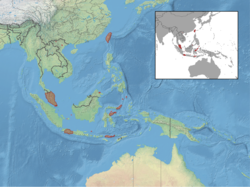| Large-footed bat | |
|---|---|
 | |
| Scientific classification | |
| Kingdom: | Animalia |
| Phylum: | Chordata |
| Class: | Mammalia |
| Order: | Chiroptera |
| Family: | Vespertilionidae |
| Genus: | Myotis |
| Species: | M. adversus |
| Binomial name | |
| Myotis adversus Horsfield, 1824 | |
 | |
The large-footed bat, large-footed mouse-eared bat or large-footed myotis (Myotis adversus) is a species of vesper bat (family Vespertilionidae). It can be found in the following countries: Australia, Indonesia, Malaysia, Papua New Guinea, Singapore, Solomon Islands, Taiwan, Vanuatu, and possibly Vietnam.
